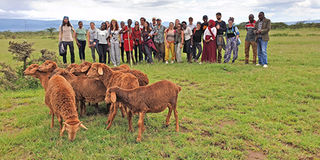Race to save the Red Maasai sheep from extinction gathers pace

Researchers and some Maasai community members pose with Red Maasai sheep in Suswa, Maai Mahiu. Also known as Tanganyika, the Red Maasai is a native sheep breed traditionally reared by the Maasai across East Africa. PHOTO | RACHEL KIBUI | NATION MEDIA GROUP
What you need to know:
- Also known as Tanganyika, the Red Maasai is a native sheep breed traditionally reared by the Maasai across East Africa.
- It has indigenously been found in southern Kenya, northern Tanzania and some parts of Uganda, in arid and semi-arid regions along the Great Rift Valley
- The NGO had to source the flock from a conservationist in Narok, says Samson Kiiru, a coordinator with Slow Food Kenya.
- The Red Maasai sheep, locally known as Enker Nanyoike, he says, has been vanishing and is almost becoming extinct.
A drive along the Naivasha-Maai Mahiu road is breathtaking, with most farms currently tilled as farmers wait to plant new crops to maximise on the long-rains season.
Apart from the tilled farms, one can also pick out flocks of sheep and herds of cattle leisurely grazing along the road and some in the fields yonder.
A few kilometres from Maai Mahiu town in Satellite village, Suswa, we meet farmer Benson ole Kaleke.
His compound hosts a special flock of sheep, all red-brownish, aged about six months and grazing separately from the rest of his livestock.
These are the Red Maasai sheep and there are 15, donated to him by Slowfood Kenya, an NGO, as it seeks to promote the breed that is slowly becoming rare.
Also known as Tanganyika, the Red Maasai is a native sheep breed traditionally reared by the Maasai across East Africa.
It has indigenously been found in southern Kenya, northern Tanzania and some parts of Uganda, in arid and semi-arid regions along the Great Rift Valley
Over the years, however, the Red Maasai sheep has become rare, with people keeping mainly Dorper and Merino.
The NGO had to source the flock from a conservationist in Narok, says Samson Kiiru, a coordinator with Slow Food Kenya.
“We bought 24 sheep and distributed to two groups, one of which is in Narok,” says Kiiru, who on this day is accompanied by visiting researchers from Italy, Germany and Kenya seeking to know more about the sheep.
Kaleke notes that he is the custodian of the sheep, which belongs to a group consisting of 15 neighbours, with each owning one.
The Red Maasai sheep, locally known as Enker Nanyoike, he says, has been vanishing and is almost becoming extinct.
This is due to farmers adopting hybrids like Dorper introduced in the area around 1986.
“As livestock keepers, we were convinced that the hybrids were more productive, early maturing and would earn us more money,” he recalls
EFFORTS BY THE GOVERNMENT
Indeed, the hybrids take a year to mature, unlike the indigenous Red Maasai breed that takes 18 months.
And at maturity, the hybrid weighs 25-30 kilogrammes, more than half of that the indigenous breed.
However, over time, pastoralists have come to appreciate that Enker Nanyoike was not only an important part of their culture but had its own advantages.
For instance, the Red Maasai sheep is highly resistant to diseases and pests and does not need frequent deworming and medication, making it climate-smart.
But the challenge of losing indigenous sheep breeds to hybrid varieties is not just in Kenya.
Dr Gabriele Volpato, a pastoralism expert from Italy-based University of Gastronomic Sciences, says over the years, high-yielding breeds have steadily replaced indigenous breeds across the world.
He adds that in Italy, for instance, the indigenous sheep breeds had nearly become extinct but there are efforts to revive them to mitigate the effects of climate change.
“It makes sense to have as many breeds as possible such that if a calamity hits, at least some of the breeds — the most resistant — will survive,” says Volpato.
Dr Leshan Koyia, a veterinary officer with the Narok County government, says there are efforts by the government and development partners to bring back the Red Maasai breed.
“We have been buying the sheep from government farms such as the Kenya Agricultural and Livestock Research Organisation (Kalro) and giving to breeder groups for breeding,” says Dr Koyia, adding that the breed is drought and disease-resistant and is worm-tolerant.
Red Maasai sheep meat is sweeter because the breed feeds on indigenous herbs and licks natural salt in the fields, he offers.
There are crossbreeds between the Red Maasai and hybrids, but with time, they take the characteristics of the latter, according to Margaret Tunda, a campaigner for Maasai culture preservation.
The researchers agreed to come up with a mobile app to link up all pastoralists who are still keeping the Red Maasai sheep





